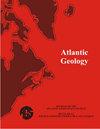Ediacaran and Cambrian rocks on Scatarie Island and nearby Hay Island, Avalonian Mira terrane, Cape Breton Island, Nova Scotia, Canada
IF 0.9
4区 地球科学
Q2 GEOLOGY
引用次数: 2
Abstract
Scatarie Island and adjacent Hay Island, located 2 km east of the eastern tip of the Avalonian Mira terrane of southern Cape Breton Island, Nova Scotia, contain a succession of epiclastic and other sedimentary rocks of inferred Ediacaran to Cambrian age. The age assignment was based previously on lithological comparison with the Main-à-Dieu Group and overlying Bengal Road and MacCodrum formations of the Mira River Group. Detrital zircon grains from two sandstone samples from the Bengal Road Formation yielded typical Avalonian detrital zircon spectra with middle to late Neoproterozoic, Meso- to Paleoproterozoic (1300–2200 Ma) and Neoarchean ages. They indicate maximum depositional ages of 532.4 ± 4.2 Ma and 525.4 ± 2.4 Ma from essentially the same stratigraphic level, consistent with the interpretation that the rocks are Cambrian. The Bengal Road Formation also yielded scarce organic-walled microfossils including an acanthomorphic acritarch identified as Polygonium sp., also consistent with Cambrian age. The fine-grained siliciclastic succession on Hay Island, tentatively attributed to the MacCodrum Formation, yielded trace fossils, including Teichichnus isp. and Gyrolithes scintillus, that confirm Cambrian age. The Hay Island Gyrolithes scintillus expands the geographical distribution of this ichnospecies, previously known mainly from the Chapel Island Formation of Newfoundland, and represents a younger occurrence.加拿大新斯科舍省斯卡塔里岛和附近的海伊岛、阿瓦隆米拉地体、布雷顿角岛上的埃迪卡拉纪和寒武纪岩石
位于新斯科舍省布雷顿角岛南部阿瓦洛尼亚米拉地体东端以东2公里处的Scatarie岛和邻近的Hay岛,包含了一系列埃迪卡拉纪到寒武纪的碎屑岩和其他沉积岩。之前的年龄分配是基于与Main-à-Dieu组和上覆的Mira River组的Bengal Road组和MacCodrum组的岩性比较。孟加拉路组2个砂岩样品的碎屑锆石谱具有典型的新元古代中晚期、中古元古代(1300 ~ 2200 Ma)和新太古代的Avalonian碎屑锆石谱。其最大沉积年龄分别为532.4±4.2 Ma和525.4±2.4 Ma,与寒武系的解释一致。孟加拉路组还发现了罕见的有机壁微化石,包括一种被鉴定为Polygonium sp.的棘形兽,也符合寒武纪时代。海岛的细粒硅屑演替,暂定为MacCodrum组,产生了微量化石,包括Teichichnus isp。和Gyrolithes scintillus,证实了寒武纪的时代。Hay Island Gyrolithes scintillus扩大了这种鱼的地理分布,以前主要来自纽芬兰的Chapel Island组,代表了一个更年轻的物种。
本文章由计算机程序翻译,如有差异,请以英文原文为准。
求助全文
约1分钟内获得全文
求助全文
来源期刊

Atlantic Geology
GEOLOGY-
CiteScore
2.10
自引率
18.80%
发文量
0
审稿时长
>12 weeks
期刊介绍:
Atlantic Geology (originally Maritime Sediments, subsequently Maritime Sediments and Atlantic Geology) covers all aspects of the geology of the North Atlantic region. It publishes papers, notes, and discussions on original research and review papers, where appropriate to the regional geology.
 求助内容:
求助内容: 应助结果提醒方式:
应助结果提醒方式:


